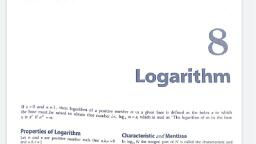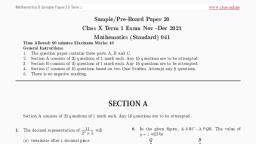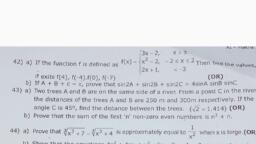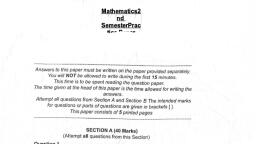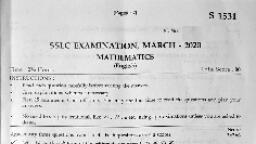Page 1 :
Paper-I : Mathematics |, , , , , , 1. What is the interval over which the function f(x), = 6x —x°, x> 0 increasing ?, (A) (0,3) (B) (3,6), © 6,9 (D) None of these, , 2. Whatis [Ve dr equal to?, (A) 2e% (x-2V¥+2)+e, (B) 2c“ (x+2Jx4+2)+e, (© 2e% (x+2Vx+2)-c, , (D) 2e%(x-2Vx-2)+e, 3. What is the degree of the differential equation, , (+2) -(2), l+—] =|— 7] ?, dx ad) *, (A) 1 (B) 2, (© 4 () 8, 4. What is the general solution of (1 + e')dy=e' de?, (A) y= log [c* (e" + 1)], (B) y=log[(e" + 1)], (© y=log[e (e' + 1], (D) None of the above, Where c is a constant of integration., , a4 dx, 5. What is the vlue of fi écGuveuel., sin xcos.x, (A) 2log 8 ®) bog 3, (© 2bg3 (D) 4log3, 6. Iffand gare two increasing functions such that, fog is defined, then which one of the following is, correct ?, , (A) fog is always an increasing function, (B) fog is always a decreasing function, , (©) fog is neither an increasing nor a decreasing, function, , (D) None of the above, , . What is the value or( f e(+- + ar] ?, , Tr ees, A) 45, , ®) e(e-1), , 1, © e-, e, @) 0, Which one of the following is the differential, , equation to family of circles having centre at the, origin ?, , 2_ Bn, (A) Q°-y Ve 2xy, , (B) G+ rye =2xy, , © Ba(st+y’), , (D) xdx +ydy=0, , . What is the area under the curve f(x) =xe' above, , the x-axis and between the linesx = Oand x= 1?, 1, , (A) z sq unit, , (B) 1 sq unit, 3, , © > squnit, 2, , (D) 2sq unit
Page 2 :
12., , 13., , 14., , , , What does the solution of the differential, , d », equation x 7 = y represent ?, , (A) Family of straight lines through the origin, , (B) Family of circles with their centres at the, origin, , (©) Family of parabolas with their vertices at the, , origin, (D) Familiy of straight lines having slope | and, not passing through the origin, , What is the coefficinent of x"’ in the expansion, , sae, or(29-2] ?, , ay 189 561, A B® >, , 21, (@) iva (D) None of these, , What is the derivative of sin? x with respect to, cos? x ?, , (A) tan? x B) cos? x, , (© -1 @)1, , Consider the following statements, , 1. f()=|x—3]is continuous at x= 0., , 2 f()=|x—3])is differentiable at x=0., Which of the statements given above is/are, correct ?, , (A) lonly (B) 2only, , (©) Both | and2 (D) Neither | nor2, , What is (111), + (1001),~(1010), equal to?, , , , (A) (1D, B) (1100),, © (i110), ©) (1010),, What is Ot! couat to?, , at is cosg oaual to?, , sin0 + cos 0-1, sin@ + cos 0+1, , sin® + cos 0+1, sin®+cos 0-1, , , , sin®—cos@—1, , sin8+cos0+1, , sin®—-cos0+1, sin® + cos0-1, , 0), , 16, One of the angle ofa triangle is 1/2 radian and, the other is 99°. What is the third angle in redian, , , , measure?, 9x—-10 90x—100, ®) Tnx, 9x-10, (C) (D) None of these, , , , 17. Tow poles are 10m and 20m high. The linejoining, their tops makes an angle of 15° with the, horizontal. What is the approximate distance, , between the poles ?, (A) 353m (8) 373m, © 4im () 4m, ’ . 4 1, 18. What is the value of sin ‘5 * 2tan ! 3?, t n, (A) 3 (B) 2, x x, © 4 @) 6, . je 4 £0sec] 8° } o, 19. What is secl44° Gosec 144° 144° equal to ?, (A) sec 18° (B) cosec 18°, (C) -sec 18° (D) —cosec 18°, , 20. Ifa and B are positive angles such that a + B=, , > then what is (1 + tan a) (1 +tan B) equal to?, , (A) 0 B) |, © 2 (D) 3, 21. What is the value of (sin 50°— sin 70° + sin 10°)?, , 1, (A) 1 (B) ny
Page 3 :
24., , 25., , 26., , 27., , 28,, , , , , , . IfcosA+B=mand sm A+ sin B= n, where m,n, # 0, then what is sin (A + B) equal to?, A 2mn, A) an ®) an, m+n mn, © 2mn ©) m+n, . If y= sec? 0+ cos? 0, where 0<0< $ sthen which, one of the following is correct ?, (A) y=0 (B) O<y<2, (© y>2 (D) None of these, Iftan A=3/4 and tan B=— 12/5, then how many, values can cot (A — B) have depending on the, actual values of A and B?, (A) 1 (B) 2, © 3 (D) 4, What is the value ofsin 15° sin 75° ?, (A) 1/4 (B) 1/8, © 1/16 (@)1, What is the equation to the straight line joining, , the origin tothe point of intersection of the lines, , q, , xy xy, +2 =Jand [+= =1?, boa, , b, (A) x+y =0 @B) x+yt+1=0, (© x-y=0 (D) x+y+2=0, What is the equation to circle which touches, , both the axes and has centre on the linex + y= 4?, (A) © +y—4x+4y+4=0, (B) xe +y’-4x-4y +4=0, (Q xrt+y'+4x—-4y-4=0, (D) +)? +4x+4y-4=0, , Ifthe position vector ofa point P with respect to, origin O is i+3j-2K and that of a point Q is, 3i+j—2k, then what is the position vector of, the bisector of the angle POQ ?, , (A) i-j-k, , (B) i+j-k, , © i+j+k, , (D) None of these, , 29., , 30., , 31., , 32., , 33., , If the straight lines x — 2y = 0 and ke + y=, , , , 1, intersect at the point (.3), then what is the, , value of k ?, (A) 1, , (B) 2, , © 1/2, (D) -1/2, , Let a, b and c be the distince non-negative, , numbers. If the vectrosa ai+aj+ck,, , i+k,ci+cj+ok lic on a plane, then which one, , of the following is correct ?, , (A) cis the arithmetic mean ofa andb, (B) cis the geometric mean ofa andb, (©) cis the harmonic mean ofa andb, (D) cis equal to zero, , The relation, , R= {(1, 2), (2,2), (3, 3), (1,2), (2,3), (1,3)}, onaset A= {1, 2,3} is, , (A) reflexive, transitve but not symmetric, , (B) reflexive, symmetric but not transitive, , (©) symmetric, transitve but not reflexive, , (D) reflexive but neither symmetric nor transitive, , 1-3 2, f|2 -8 5, 42:1, , what is the value of 2?, , (A) -1 ®)0, , © 1 (D)2, , What is the number of words that can be formed, form the letters of the word ‘UNIVERSAL’, the, vowels remaining always together ?, , (A) 720 (B) 1440, , (©) 17280 (D) 21540, , The arithmetic mean of two numbers exceeds, their geometric mean by 2 and the geometric, mean exceeds their harmonic mean by 1.6. What, are the two numbers ?, , (A) 16,4, , () 81,9, , (C) 156,16, , (D) 625,25, , is not an invertible matrix, then
Page 4 :
35., , 36., , 37., , 38., , 39., , 41., , What is the oo) (2) 2, at is the cojugate 21)?, , (A), © 75., © -3t'55, ©, , If the equations x° + kx + 64=0O and x —8x+ k=, 0 have real roots, then what is the value of k ?, , , , (A) 4 ®) 8, © 2 (D) 16, What is equal to ?, (A) -1 @) 0, ©1 () 2, , “oP [a “ipe[s a] te, , which one of the following is nor correct ?, , si, , (A) A?=B (B) B=C?, (Q AB=C (D) AB=BA, If log, [log, x[log, x]] =log,, 3 then what is the, , value of x ?, , (A) 3 (B) 27, © ) 3”, . If is a complex cube root of unity, then what is, @'° + @'° equal to?, (A) 2 ) -1, (Q -2 @)1, , If the roots of the equation, , (a+ b*) 7° -2b (at c)x+(b +07)=0, , are equal, then which one of the following is, correct ?, , (A) 2b=ate, , (B) b=ae, , (QC b+c=2a, , (D) b=ac, , 42. What is the maximum number 0 straight lines, that can be drawn with any four points in a plane, such that each line contains at least two of these, , points ?, , (A) 2 (B) 4, , © 6 @) 12, 6 i 1, , 43. Ifx+iy=|4 3% —1), then what is x -iy, , 20 3 7, , equal to ?, , (A) 3+7 (B) 143:, , © 3i (D) 0, , 44. If|A|=8, where A is square matrix of order 3,, then what is | adj A| equal to?, (A) 16 (B) 4, C) @ @) 512, 45. What is the binary number equaivalent of the, decimal number 32.25?, (A) 100010.10, (B) 100000.10, (©) 100010.01, (D) 100000.01, , 46. From the top of a lighthouse 120 m above the, sea, the angle of depression of a boat is 15°. What, is the distance of the boat form the lighthouse ?, (A) 400m (B) 421m, © 444m () 460m, , sin 0+ cos 0 —tan®, , 47. What is the value of 53-94 cosecO—cot® °, , when 0= = 2?, (A) 0 @) 1, © -1 (D) None of these, , 1, 48. What is the value ofsin 292 ra 2, , a) ava @) -3 2-8, © svt ©) ah
Page 5 :
49., , 50., , 51., , 52., , 53., , , , What is Jace" X tan x dx equal to ?, , , , , , , , , , sec" x x, (A) +e ‘B) +c, n n-1, tan" x tan" x, © . *C ) Rol *e, , What is the artea bounded by the curve y = x°, and the line y= 16 ?, , (A) 32/3 (B) 64/3, , (CQ) 256/3 (D) 128/3, , What is the number of terms in theexpansion of, (a+b+ce)",nEeN?, , (A) n+1 (B) n+2, , (n+ 1)(n+2), 2, , What is the number of signals that can be sent, by 6 flags of different colours takinng one or, moreata time?, , (A) 21 B) @&, , ( 720 (D) 1956, , In how many ways can a committee consisting, of 3 men and 2 women be formed form 7 men and, , 5S women ?, , (Q n(n+1) @), , (A) 45 {B) 350, (© 70 (D) 4200, 54.1f g= i-k, , 55., , 56., , b = i+ j+0-k, ¢ = pit+xj+(+x-y)k,, , thn a-(bxc) depends on, , (A) x only, , (B) yonly, , (©) Bothx andy, , (D) Neither xnory, , What is the probability of having 53 Sundays or, 53 Mondays in a leap year ?, , (A) 2/7 (B) 3/7, , (© 4/7 (D) 5/7, , Three digital number are formed using the digits, 0, 2, 4, 6,8. Anumber is chosen at random out of, these numbers. What is the probability that the, number has the same digits ?, , 57., , (A) 1/16 (B) 1/25, , (CC) 16/25 (D) 1/645, , What is the mean deviation of the data 2,9, 9, 6,, 9,4?, {A) 223, ©) 323, , (B) 257, (D) 3.57, , 58. A set on n values x,, x, ...., x, has standard, , 59., , 61., , 62., , deviation o. What is the standard deviation ofn, values x, + k,x,+k...,x, +k?, , (A) o B) o+k, , () o-k Mj ka, , The two lines of regression are 8x — 10 = 66 and, 40x — 18y = 214 and variance of x series is 9., What is the standard deviation of y series ?, {A) 3 8) 4, , ©) 6 @)9, , . The standard deviation of some consecutive, , integers is found to be 2. Which of the following, , statements best describes the nature of the, , consecutive integers ?, , (A) The integers are any set of cight consecutive, integers, , (B) The integers are any set of eight consecutive, positive integers, , (C) The integers are any set of seven, consecutive, , (D) None of the above, , IfA and B are two disjoint sets, then which one, of the following is correct ?, , (A) A-B=A-(ANB), , (B) B-A'=BNA, , (C) ANB=(A-B)AB, , (D) All ofthe above, , Consider the following statements in respect of, a square matrix A and its transpose AT, , 1. A+ATis always symmetric., , 2 A-—ATis alwaysanti-symmetric., , which of the statements given above is/are, correct ?, , (A) lonly, , (©) Both | and2, , @) 2only, (D) Neither | nor2, , . Ifa and B are the roots of the equation x7 - 2x +, , 4=0, then what is the value of a’ + B’?, (A) 16 (B) -16, ©) 8 (D) -8
